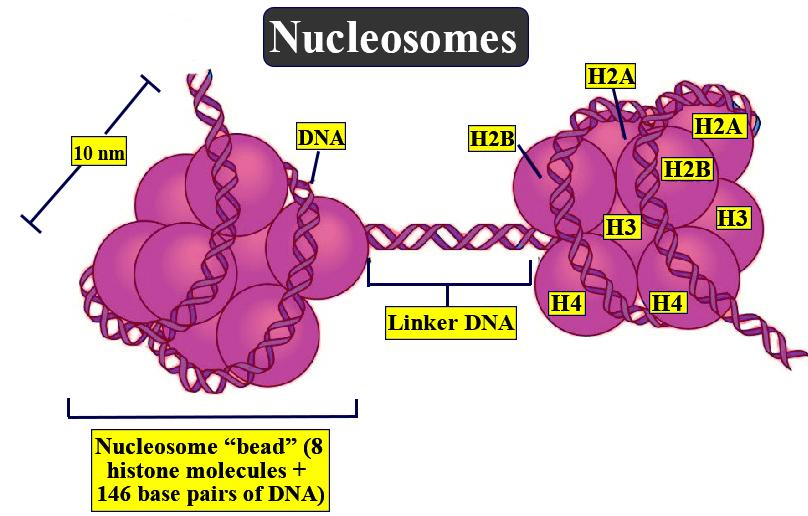
Which of the following is a part of nu-body?
(a) Histone octamer
(b) DNA + core of the nucleosome
(c) H 1 protein
(d) 1 ¾ turn of DNA + H 1 protein
Answer
436.2k+ views
Hint: Nu-body is the complex of protein present at the center of the nucleosome. This protein is very helpful as without it in the chromosome the DNA that is unwounded will be very long. It helps in the winding of DNA and functions in gene regulation.
Complete answer:
Every chromosome in a eukaryotic cell is composed of DNA which is wound and dense around an octamer of essential proteins called histones. The nu-body is the part of chromatin that is made up of DNA and is wrapped around histone protein molecules. The histone protein consists of eight complexes of proteins with two copies each, they are H2A, H2B, H3, H4. They are together called histone octamers.
-The histone proteins in the core of the nucleosome are H1, H2A, H2B, H3, H4 which are significant for the arrangement of chromosome structure or build-up of DNA.
-The DNA length is more easily observed than the compartment and its size where the DNA is stored in the core.
-The histones are the spool-like proteins that keep DNA from the chromosomal structure at its place and hold it firmly.
-The core of nucleosomes composed of various types of histones that are H2A, H2B, H3, and H4, and H1/H5 that are called the linker histones.
-The histones present in the core of the nucleosome are all similar in structure as they all are in forms of dimers having similar histone fold domain: three alpha-helices linked by two loops.
-The nu-body will consist of two copies of each histone protein along with nucleotide base pairs of around 140 bp.
So, the correct answer is ‘Histone octamer’.

Note:
The term histone was derived from the Greek word ‘Histon’, ‘histanai’, or ‘histos’ in the late nineteenth century. The word was first discovered by Albrecht Kossel in 1884. In the 1950s, a new type of histone called H5 was discovered which was found to be the isoform of H1 histone.
Complete answer:
Every chromosome in a eukaryotic cell is composed of DNA which is wound and dense around an octamer of essential proteins called histones. The nu-body is the part of chromatin that is made up of DNA and is wrapped around histone protein molecules. The histone protein consists of eight complexes of proteins with two copies each, they are H2A, H2B, H3, H4. They are together called histone octamers.
-The histone proteins in the core of the nucleosome are H1, H2A, H2B, H3, H4 which are significant for the arrangement of chromosome structure or build-up of DNA.
-The DNA length is more easily observed than the compartment and its size where the DNA is stored in the core.
-The histones are the spool-like proteins that keep DNA from the chromosomal structure at its place and hold it firmly.
-The core of nucleosomes composed of various types of histones that are H2A, H2B, H3, and H4, and H1/H5 that are called the linker histones.
-The histones present in the core of the nucleosome are all similar in structure as they all are in forms of dimers having similar histone fold domain: three alpha-helices linked by two loops.
-The nu-body will consist of two copies of each histone protein along with nucleotide base pairs of around 140 bp.
So, the correct answer is ‘Histone octamer’.

Note:
The term histone was derived from the Greek word ‘Histon’, ‘histanai’, or ‘histos’ in the late nineteenth century. The word was first discovered by Albrecht Kossel in 1884. In the 1950s, a new type of histone called H5 was discovered which was found to be the isoform of H1 histone.
Recently Updated Pages
Master Class 11 Accountancy: Engaging Questions & Answers for Success

Glucose when reduced with HI and red Phosphorus gives class 11 chemistry CBSE

The highest possible oxidation states of Uranium and class 11 chemistry CBSE

Find the value of x if the mode of the following data class 11 maths CBSE

Which of the following can be used in the Friedel Crafts class 11 chemistry CBSE

A sphere of mass 40 kg is attracted by a second sphere class 11 physics CBSE

Trending doubts
10 examples of friction in our daily life

One Metric ton is equal to kg A 10000 B 1000 C 100 class 11 physics CBSE

Difference Between Prokaryotic Cells and Eukaryotic Cells

State and prove Bernoullis theorem class 11 physics CBSE

What organs are located on the left side of your body class 11 biology CBSE

The combining capacity of an element is known as i class 11 chemistry CBSE




